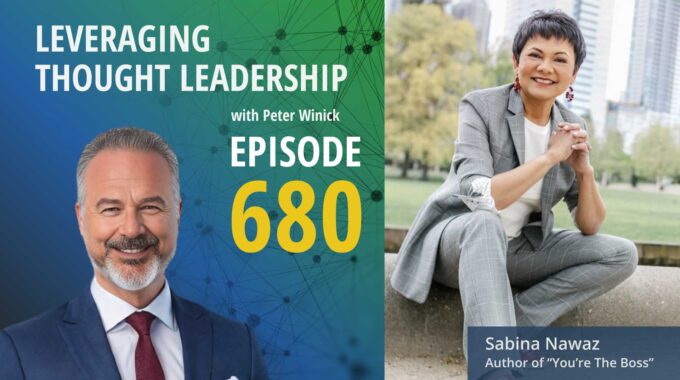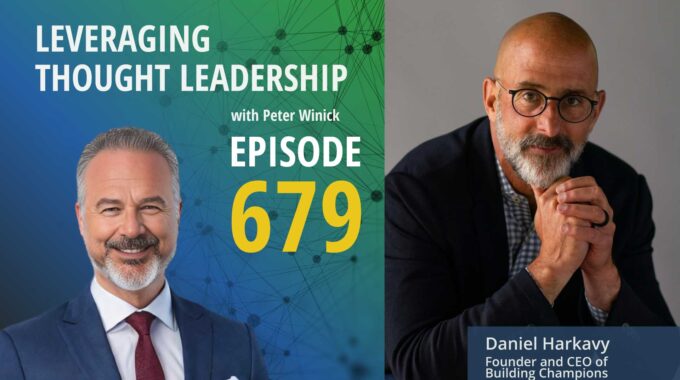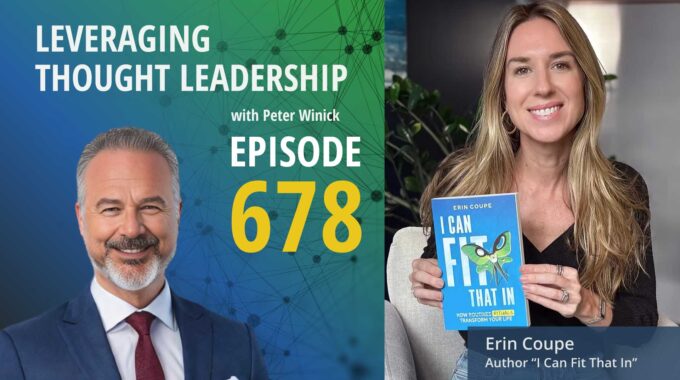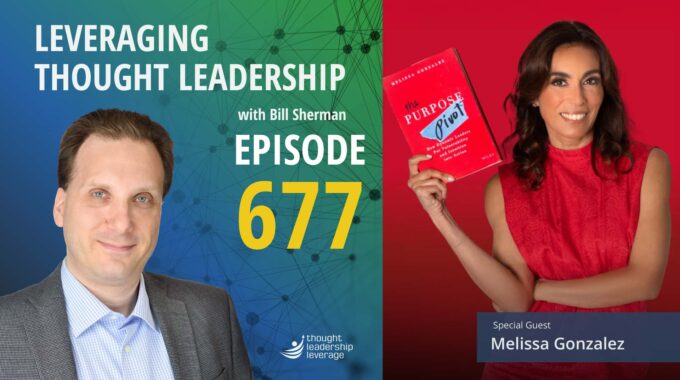The Hidden Cost of Corporate Pressure—and How Leaders Can Rise Above It This episode explores…
Unlocking the Power of Education | Russell Kern
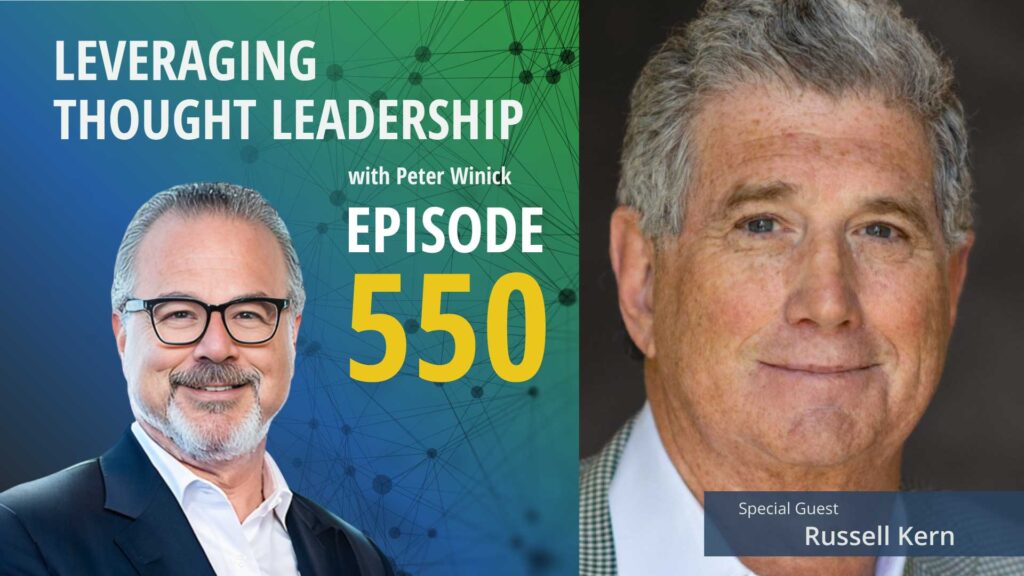
Insights on Business Development
An interview with Russell Kern about creating educational thought leadership that speaks to the audience’s pain.
In this episode, we sit down with Russell Kern, a seasoned business leader, entrepreneur, author, and speaker renowned for his expertise in organizational development and the transformative potential of effective coaching. As the founder of Kern and Partners, Russell has dedicated himself to optimizing human capital and empowering high-performance teams. Russell shares his insights on leveraging thought leadership to drive business growth through education, embracing the philosophy of “Give to get.” Rather than focusing solely on brand recognition, Russell emphasizes the importance of addressing the immediate problems and challenges faced by his audience. He likens his thought leadership to “pain magnets,” aiming to provide relief and solutions to pressing issues. Russell emphasizes the need for practical, actionable content that facilitates skill mastery and drives behavior change.
Distinguishing thought leadership and content marketing, Russell highlights the importance of credibility and relevance in thought leadership. He underscores the need for visually engaging, quick-hitting content that captivates and excites the audience, whether it’s through traditional mediums or emerging platforms like TikTok.
Join us as we explore the strategies behind effective thought leadership and learn how to craft compelling content that resonates with your audience in today’s fast-paced digital landscape.
Three Key Takeaways:
- You can draw in your target audience by creating thought leadership that not only speaks to their problems at the moment but also provides the promise of a solution.
- Smaller firms can benefit immensely from investing in thought leadership, allowing them to punch above their weight class.
- Effective thought leadership needs to grab the audience’s attention. Make sure it is visually compelling and quick-hitting.
If you need a strategy to bring your thought leadership to market, Thought Leadership Leverage can assist you! Contact us for more information. In addition, we can help you implement marketing, research, and sales. Let us help you so you can devote yourself to what you do best.

Transcript
Peter Winick And welcome, welcome, welcome. This is Peter Winick. I’m the founder and CEO at Thought Leadership Leverage. And you’re joining us on the podcast today, which is Leveraging Thought Leadership. Today. My guest is Russell Kern. He brings over 40 years of seasoned experience as a business leader, entrepreneur, author, educator, and speaker to the forefront of organizational development. His zeal lies in educating on the transformative power of effective coaching for cultivating high performance teams. He’s the founder of, Kern and Partners, which is a consultancy specializing in human capital optimization. He lives in LA with his wife, Meryl, their four horses, and Penny, their affectionate labradoodle. We’re going to give a shout out to Penny there, because.
Russell Kern Both Penny gave Penny and now Penny has a. Now Penny has a sibling named Teddy.
Peter Winick Oh, there we go. Okay, we have.
Russell Kern A little puppy. Little goldendoodle. Newborn.
Peter Winick So this is what happens with the second child or puppy. We forget about the bio. That is correct. Welcome today, Russell. Thank you for your 40 years. Right.
Russell Kern So that’s 40 years. I started, almost right out of college. I was selling jelly beans when I was 19 on a pushcart in a mall during the Ronald Reagan era. I learned all about sales from standing on stand and right there in the middle of a mall and around 20.
Peter Winick Well, I actually you got to give that some context, though, because for those of a certain generation, they didn’t realize that Reagan was probably the biggest marketer of for the jelly bean industry up until that point. Quite. It was that of darkness, as that was sort of part of his brand carry through.
Russell Kern So there’s a very you know, I have a photo of me anyway, I sold jelly beans. And then sales led me to marketing from leading UCLA. I started my own agency somewhere around 24. I was always a student of the craft of marketing, most importantly, direct response marketing. My father and I used to look at what used to be known as the New York Times Magazine. I know all I’m dating myself and the mail order ads again, dating myself, right? But in the end, it’s all about human persuasion. And so for those 40 years, I took a little two man agency, 25, 50, 100, 200, sold it, and then stayed on to break it to 400 and transitioned to my new successive successor team. And they’re doing great. So lots of lots of lessons.
Peter Winick So talk about sort of the thought leadership side of that. Right. So you ran an agency, built an agency.
Russell Kern Sure, sure. But the agency was built from thought leadership. So we grew the business as I’m growing now, this business through educating the give to get we would create thought leadership that was focused not necessarily on the future of marketing, but on the problems the marketers are facing in that moment. Because for us, our content was about finding those that were in trouble or need or worry. And so I always think of thought leadership at least lower funnel, what I’ll call pain magnets not often met with an all day we call them offers, but I call them pain Max because I want my thought leadership to be giving you a sense of relief that there’s an answer to your problem, and that from that leadership content, whether it’s a class or program, a webinar, we can now have a discussion about solving that problem. So to me, thought leadership was not so much about branding as it was about biz dev. Now, I did write a book called Surefire Direct Response Marketing published by McGraw Hill. As part of my thought leadership, I wrote multiple guides on marketing, probably 20 guides on marketing for our brand and establishment. But again, there was an overarching thematic of the purpose of that thought leadership as it relates to business growth and development, not just thought leadership for brand recognition.
Peter Winick So a couple of follow up thoughts there. So one is when you’re putting out the pain magnets I like that we call them pain points sort of same thing. It also signals that you’re putting them first, but you’re not talking about your products or offering them solutions. And there’s a little bit of IQ, right? There’s a little bit of, wow, I know the things that are keeping you up at night, that maybe you’re saying them out loud, or maybe I’m putting words to things that you’re feeling potential client, prospect, whatever. And I put a lot of thought into it. And here it is in the form of thought leadership. So I think there’s a big piece of that where people lean in and go, yeah, tell me more.
Russell Kern Yes. So I would say specifically for right now, Kerner Partners, where our thought leadership is, I created three new pieces of content for what we’re calling the magnificent mid-level manager. Well, one is what are the 12 behaviors of an asset manager? And what was all the research? Here’s a checklist for you to determine you, the senior leader or yourself. Am I really a magnificent mid-level manager? And then I went as far as to say is and here’s a manifesto. For you to write to give to a team member, which says, I promise to be this type of leader to you. And so those three pieces of content which creates a collection are really about training and development and specificity of solving the issues to elevate. So that’s the type of thought leadership content that I’d like to create. I know works and I know attracts for what I want.
Peter Winick I like that that’s very apply. Right. Because there’s you know, when you look at thought leadership on a continuum, on a spectrum, there’s academic stuff, which is great, but sometimes it’s so clunky and so thick and so, you know, rich in data that you can’t walk away from and say, well, what am I supposed to do now? What do I do? Right? And then there’s other stuff that’s sort of very light on the research. It’s more anecdotal or based on charisma, or do it because I say where you’re like, maybe that’s right, maybe that’s wrong. I don’t have a I don’t have the evidence underneath it. So I love that you’ve got it’s evidence based but very applicable, approachable.
Russell Kern So and I think that, Peter, that comes from the aspect of as a neuro marketer, that was my training when it comes to changing behaviors, what we’re seeking to do is make the brain more efficient by practicing skills. And what I know in our thought leadership is it’s one thing to know what the statistics are, whether it be from Gallup or McKinsey, who does great thought leadership and great stat. But if I’m going to help, if we’re going to help with our thought leadership, it needs to be small and pragmatic with practice, because that’s what allows us to gain mastery. Just like going to the driving. I don’t know if you’re a golfer, I’m a golfer, you know? And so if I practice, I practice, I get better. And so in thought leadership, I want to give pragmatic content that they can practice with.
Peter Winick You touched on something there that I want to unpack, which is Gallup and some of these big folks, etc.. One of the things that I think is really, really cool and wonderful and beautiful about thought leadership is it’s an equalizer. It’s the democratization in that current in partners is not nearly as big as Gallup. I’m going guess right, but you could be as smart or smarter than many of the people at Gallup. Right? So yes, there’s even to be made. And whether it’s Gallup or a big an agency or consultancy, whatever, my point is that the size limit of a smaller consultancy agency, organization, whatever should not be a deterrent to investing in thought leadership. In fact, it’s the opposite, right? Because current partner is probably not buying an ad on the Super Bowl this year.
Russell Kern We’re going to go we’re not no, no Super Bowl ads. But from starting this business for the last six months, that’s all I’ve done is invest in thought leadership. First of all, my own thought leadership, because I went from marketer to trainer and developer and leader and coach. So I’m now surrounded by probably a hundred books and thousands of research because the, as you say, the great equalizer is I can take all that information and then presented in a way to solve a specific problem. And you and I both know the riches that are in the niches of the thought leadership. And so taking all that data and being able to condense it down to something very specific for a very specific problem, and it’s the piece that helps, as you say, to differentiate, grow, create opportunity and provide credentialing.
Peter Winick And yeah, the differentiate is big and you can punch above your weight. Right. So you may never be, you know, have offices in 38 countries or whatever. But when people look at a piece of thought leadership in whatever modality format it might be video, audio, book, article, whatever, they go, wow, that’s pretty smart. And more importantly, that’s smart. Wow. That’s really relevant to me right now. And I’ve never heard that idea expressed in that way that gives me such relief, clarity, whatever around the issue. How do I get that guy on the phone? Right. Yeah, I want to play with them because, yes, everybody, you know, I think we are all particularly in professional services fighting commoditization, right? You look at chat and you’ll get all these other things. There’s somebody else that can do what you do cheaper as well as somebody else that can do what you do, maybe faster. Maybe there’s even technology that can do it. But that connection that one makes vis-a-vis the thought leadership that’s really critical, I think, where it’s that I don’t have to persuade. I mean, you said that neuromarketing, right? I don’t have to convince you and put all these neuromarketing tricks on. Why am I good? I just put out there my smart thinking and the fly paper works, right?
Russell Kern Right. Well, in the end, people buy people they trust. And we are. We have adapted to know how to trust someone and how they communicate, what they communicate. What they share is part of the trust building that creates the relationship, that creates opportunity. Even, you know, you and I have built trust just in our few conversations by how you deliver, how you speak, what. You share. And so I think it’s a, I would say as, as anybody in the service business. Ask yourself what thought leadership you’re doing and what part of the sales journey are you trying to do. Like if you’re a little, I would never try to be McKinsey and field a 10,000 person survey globally. Like, okay, that’s suicide. On the other hand, is I know for me is I need lower funnel thought leadership against a specific pain to start the engagement. And then because I have all the knowledge I can convey trust and experience and so, so much as strategy, what you like to talk about is what is the strategy of the thought leadership content. Not that it’s not important, but what is it titled? And I’m a big fan because headline is everything.
Peter Winick Headline is what.
Russell Kern Calls. And then how is it consumable by the reader in a way that gets it to where it needs to be?
Peter Winick If you’re enjoying this episode of Leveraging Thought Leadership, please make sure to subscribe. If you’d like to help spread the word about our podcast, please leave a five-star review at rate this podcast.com/l t l and share it with your friends. We’re available on Apple Podcast and on all major listening apps as well as at thoughtleadershipleverage.com/podcast.
Peter Winick What I like how you’re mapping it against the sales process. So I want to pivot for a moment and say, one of the things that’s really interesting about thought leadership is there’s this I think it’s okay that there’s a bit of a tension or rub or whatever between sort of the content marketers and the thought leaders. So my view I’d like to hear yours is content marketing is great, right? If I just needed dentures, there’s probably a whole bunch of content. I don’t just for the record, but there’s a whole bunch of content that I’d probably want to read about. The ABCs of dentures for new use. Don’t do this, do this. I mean them all this stuff. It’s probably not thought leadership, right? If I was a new mom, which I’m also.
Russell Kern You wouldn’t call that thought leadership. You would call that lower funnel informational content.
Peter Winick Right. But I think what’s happened and this is where I was going is, you know, teaching new moms how to avoid diaper rash. Critically important. You tell it to a new mom at three in the morning when the baby’s crying because they have it right. Totally important thought leadership. It ain’t right. And I think what happens is a lot of marketers think that thought leadership has more cachet, is sexy, or is whatever. And I think there’s nothing wrong with content marketing. There’s nothing wrong with thought leadership. But they each have a role and a place, and they’re not interchangeable. How would you.
Russell Kern Yes. So I would say yes. If I look at it as the buyer and I come from a B2B buyer spectrum activist, there’s a smorgasbord of which the buyer now gets to choose from. We might use the funnel, but the bottom line is the buyer is looking. Sometimes they’re looking for what the future is going to be. Sometimes they’re looking to fix diaper rash. Will stick with your analogy in that regard. And so from the thought leadership perspective, is you want to be positioned as credible. And your thought leadership is either, a position of opposition that’s powerful, that someone wouldn’t think about or an insight that they wouldn’t think about and provides credibility. At the same time, you also need that other content to allow the buyer, the B2B buyer, to feel that you’re getting the answer. And so I don’t know how else to call. I call it the smorgasbord way of content marketing. You need everything from the lobsters and the ribs down to the desserts. And right.
Peter Winick You’re not going to McDonald’s for lobster, right? So that’s my point at McDonald’s.
Russell Kern And so all of that needs to be appropriate. And it needs to be the same thing. But the importance about the thought leadership is it saying is, you know, what you’re talking about and you have a point of view that you know.
Peter Winick These point of view. So I totally agree. And I think one of the litmus test, if you will, have a point of view, is that not everyone will agree. If not everyone, you know, if everyone agrees with you, you don’t have a point of view. You’re vanilla ice cream, you’re wishy washy. You’re not going to stand out, on the other hand, of that, you don’t want to be so belligerent or ridiculous or over-the-top or use a, you know, abusive, abrasive language or whatever to get the attention. But I think the part of a point of view is to say, hey, you know what, Russell? You’re Karl. And Karl isn’t for everybody. I just don’t like Karl. And I appreciate what you do, and I, you know, whatever I get that some people do. This might just not be a dish for me. And others would go, wow, Holy cow. Hallelujah, brother, I can’t wait to get you on the phone and sign me up. And I think that it’s the latter where, you know, if you have to be in the business of converting the way people think, you don’t get paid for that. But when I experience when people come to you after they’ve consumed a lot of your thought leadership, you know, there’s not a lot of convincing that needs to go on right now. It’s focused on. I get who you are and what you do. Let’s talk about me right and how what you do. Because now I understand that could help me go from A to B or whatever that it is, get to the other side of this thing as opposed to that part of the sales cycle. Let me tell you why I’m great. Let me tell you why I’m good. I mean, like, I don’t need to credential myself. Not.
Russell Kern And nobody really wants to hear it there. Whether coming from is. Did you awaken my brain? Have you told me something that is going to relieve my pain? Because people move from pain to pleasure. That’s just the way we’re work. Yes. You were wired. And now are you giving me something that’s either of strategic value, economic value or emotional social value? And your thought.
Peter Winick Awaken? Could I say that awaken my brain part? I think we’re struggling with that today as thought leaders. Is it used to be acceptable or standard to say, well, the way you’re going to wake in my brain is I’m going to read your book. I’m going to spend seven, eight hours reading your book. I’m going to, you know, it’s sort of steeping in your ideas, processing it, whatever. Now, the other end of that spectrum is, yeah. Can you awaken my brain on TikTok in 60s?
Russell Kern It’s so you can awaken a brain in 14 milliseconds. So it’s not about the amount, because our eyes are designed to absorb information at incredible speeds, but our eyes are also designed to not pay attention to irrelevancy. Yes. Okay. So the rock of it all is how was your thought leadership packaged in a way that is visually arresting? Was supportive. Copy that. So quick the mind go, oh, I want to pay attention to it. And that’s not easy.
Peter Winick I really like a lot of a lot of folks struggle because the way that. They’re comfortable with is, you know, long form content. Really wrestling with a problem, telling the story, putting it out there. And listen, I, you know, I read a business book or two a week. I love that. But I also watch TikTok and I there’s also other things I need the quick hit or I look at that and go, that took five seconds, let me try another and another, and then maybe I go deeper. So I love sort of the awakening the brain piece. And I think it’s an excuse today to say, well, it takes a long time to wake in the brain.
Russell Kern Right? Oh no, it does it. So that is, that is an excuse that is not we are evolved to pay attention in 14 milliseconds. Is there a line that’s going to eat us? We are primitive human beings. And it also you can see it. And when we see things we are dopamine or oxytocin get released. It’s why when we’re in a grocery store and I’m in Costco, golf balls jump into my cart when I went for the chicken. Okay, but that 10s of a TikTok or six seconds can be powerful or terrible. And so it’s not a time. But I do think you brought up repeatability and frequency matter. And so you can’t just do it in a sick one six second, you might need ten six seconds spots that build upon each other. You might need frequency because frequency does do that as well as we know from the advertising community. But it’s not an easy task to awaken. But it’s something that happens. You know, you got to work hard at it and it’s visual first. So design, I even look at my own work, I go, oh, I got some more work to do. Yeah, matters. Design matters.
Peter Winick So this has been great. As we wrap up here, any no pressure, but any final words of wisdom to someone out there? Maybe in your shoes -15 years where you were 15 years ago, like in the midst of launching a big agency or, you know, wrestling with the I kind of get this thought leadership thing, but why and how and why like any oh.
Russell Kern I would say allow for the experimentation. Just start on the journey. Use AI to help you get going. It’s been a it’s a great help. It won’t finish. It will accelerate the process. Be prepared for the evolution of your thought leadership as you get smarter of whatever you’re trying to do. And the last piece I would say is, see the niche that you’re trying to be the thought leader to if especially if you’re just starting or building, don’t be everything. Go find the rich. The riches are in the niches. Pick one and go for it hard. And then you can build bowling alleys out of, you know, crossing the chasm. Jeffrey Moore. But yes. Yeah, that’s what I’d say.
Peter Winick Cool. Well, I appreciate your time, Russell. Great stuff. Lot of great insight here today. So appreciate your time. Thanks for coming on today.
Russell Kern You’re welcome Peter, thanks for having me. All the best. We’ll talk soon.
Peter Winick To learn more about Thought leadership leverage, please visit our website at ThoughtLeadershipLeverage.com to reach me directly. Feel free to email me at Peter at ThoughtLeadershipLeverage.com, and please subscribe to Leveraging Thought Leadership on iTunes or your favorite podcast app to get your weekly episode automatically.


